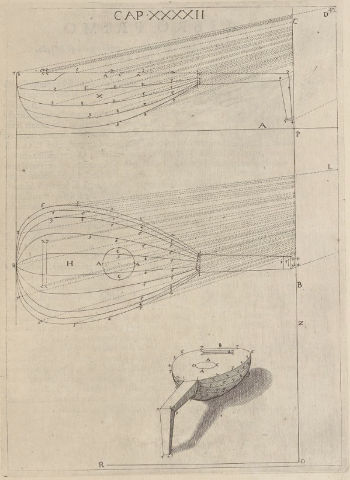Soon after Pieter Teding van Berkhout (1643–1713), a young scion of a landed gentry family from The Hague, made a visit to Vermeer's studio in June 1669, he wrote in his diary, "I went to see a celebrated painter named Vermeer." But Van Berkhout understood Vermeer's paintings differently than we do today. He described them not as "allegories" or "scenes of daily life," much less "masterpieces of light" or "suspended moments in time" that "exude silence." Van Berkhout wrote that the most "extraordinary and curious aspect" of Vermeer's art consists in "perspective."
To be sure, the Dutch term used for perspective comprises a range of artistic compositions, from see-through views (doorsien or doorsicht), like Vermeer's The Love Letter or Cornelis Bisschop's Girl Peeling an Apple (fig. 1) to perspective boxes (perspectival), or "peep-shows," as they are imprecisely called. Real and fantasy church interiors (fig. 2) were also regularly referred to as perspectives. All of these works had the overriding aim of producing the most persuasive illusion of three-dimensional depth possible. The fact that Vermeer might have been considered by a contemporary Liefhebber (art lover) first and foremost as a skilled practitioner of perspective has only recently begun to be considered.
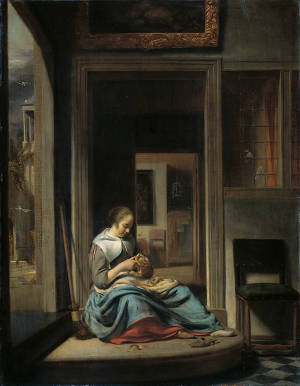
Cornelis Bisschop
1667
Oil on panel, 70 x 57 cm.
Rijksmuseum, Amsterdam
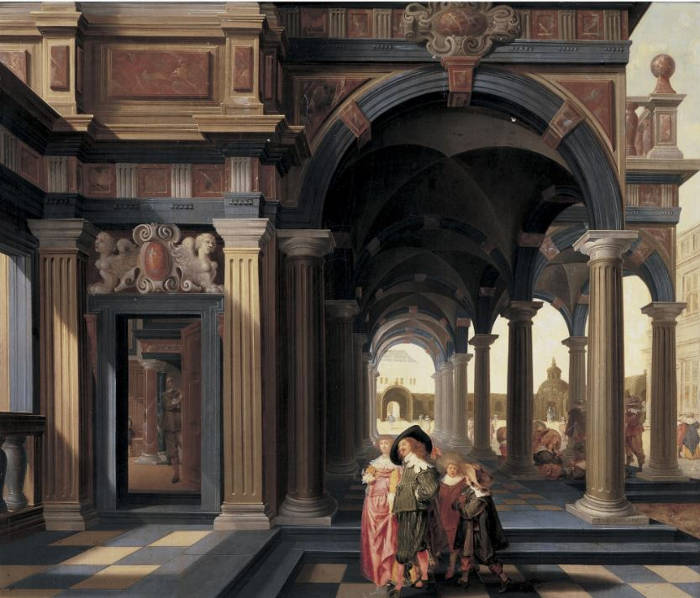
Dirck van Delen
1635
Oil on panel, 52 x 59.6 cm.
Private collection
How did Vermeer Learn Perspective?

Sandro Botticelli
1490
Tempera on panel, 49.5 x 58.5 cm.
Kelvingrove Art Gallery and Museum, Glasgow
Linear perspective was first utilized by Italian renaissance painters to represent fantasy architectural backdrops of biblical and mythological narratives (fig. 3). The more imposing and realistic was the setting, the more compelling was the narrative. These first perspectives typically featured geometrically shaped objects such as tiled floors, windows, coffered ceilings, colonnades and ceiling rafters, which are among the most conformable to perspectival projection. Oriental carpets with repetitive geometrical patterns were also used. Within a few decades after the discovery of perspective, Italian painters were able to represent architectural environments of great complexity and spatial resonance, some so spectacular that they overshadow the pictures' subject matter.
Two centuries later, Dutch architectural painters brought the application of linear perspective in painting to its zenith. The exteriors and interiors of real and fantasy churches, civic buildings, country houses and bizarre renaissance palaces (fig. 4) were rendered with astounding exactitude, sometimes combining real and imaginary elements in the same composition. The impression of three-dimensional space in many of these pictures is so compelling that even today's most jaded museum-goer cannot but share the wonderment they must have provoked in Vermeer's day.
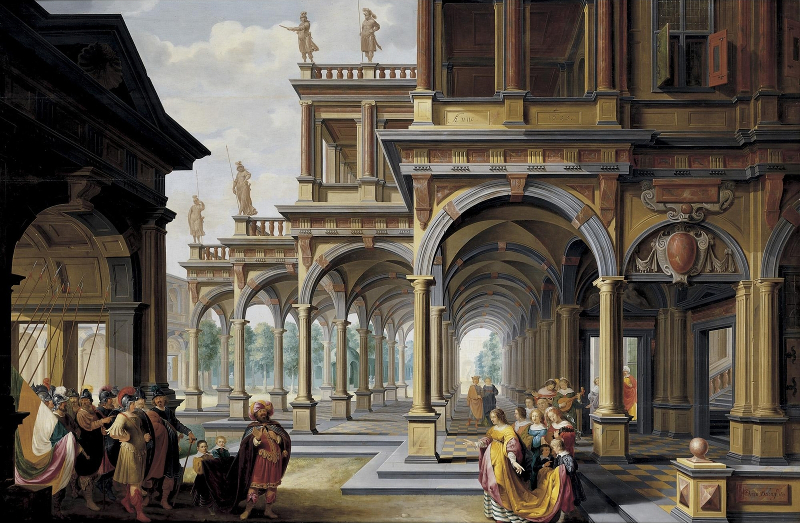
Dirck van Delen
1633
Oil on panel
Private collection
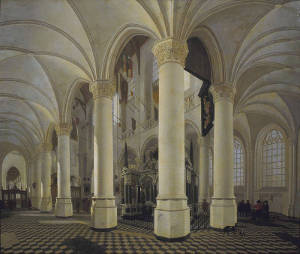
Gerard Houckgeest
c. 1651
Oil on panel, 66.5 x 77.5 cm.
Mauritshuis, The Hague
Although there is no documentary evidence that might clarify how Vermeer learned perspective, abundant resources were at his fingertips. Richly illustrated perspective manuals circulated throughout Europe, and in Delft and nearby The Hague the young painter would have been able to draw lessons firsthand from the architectural paintings of the most sophisticated practitioners of this highly prized genre, such as Emmanuel de Witte (1617/1618–1692) and Gerrit Houckgeest (c. 1600–1661). Both of these painters specialized in "perspectival portraits" of the Nieuwe Kerk (fig. 5), Delft's most prestigious landmark, which was barely a stone's throw from Vermeer's birthplace and studio.
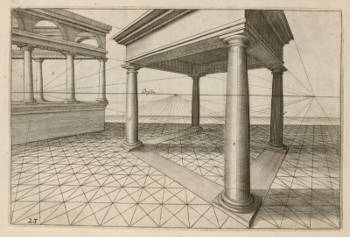
Vredeman de Vries
Published: The Hague, 1604–1605
"Among the number of perspective books available in the Netherlands, those of three Dutchmen, Hans Vredeman de Vries (1527–c. 1607), Samuel Marolois (c. 1572–c. 1627) and Hendrick Hondius (1573–1649) were important. Vredeman de Vries was completely oriented towards architecture (fig. 6) whereas Marolois saw perspective as a branch of mathematics. Marolois' text, which was far more comprehensive than Vredeman de Vries', was useful only to artists who might have sought a theoretical understanding of the laws of perspective. Hondius' treatise, like that of Vredeman de Vries, was essentially a recipe book, but more attuned to the practicing painter. None of these theoreticians were particularly innovative and none advanced beyond traditional practices, but they transmitted many fifteenth- and sixteenth-century perspective theories to artists."Kirsti Andersen, The Geometry of an Art: The History of the Mathematical Theory of Perspective from Alberti to Monge (New York: Springer, 2006), 296–297.
Influential foreign publications available to Dutch painters included Jean Pèlerin's De Artificiali P(er)spectiva, Toul, Petrus Jacobi (1505), Albrecht Dürer's Unterweisung in der Messung mit Zirkel und Richtscheit (1525) and Sebastiano Serlio's Tutte l'Opera d'Architectura et Prospettiva. Pèlerin's treatise spread the influence of perspective North of the Alps. Although his constructions are based largely on classic frontal positions, he was the first to illustrate what were referred to as the "tier point" system. This method made use of a "principal point" (central vanishing point) and the two lateral "tier points" (distance points) to create objects set at an angle 45 degrees to the viewer's line of sight. Furthermore, Pèlerin recognized that the distance points needed to be moved further from the vanishing point as the spectator's distance from the subject increased, a concept necessary for implementing a rationally based illusion of space.
The Frenchman did not, however, elaborate this relationship in mathematical terms. Both ingredients were crucial for devising the perspectives of Vermeer. Sebastiano Serlio's treatise on perspective and geometry published in Paris in 1545 was one of the first volumes to approach the subject in a practical manner, adapted for artists, although Serlio himself remarked that perspective is "an art that cannot be easily understood from figures or written texts, as when being taught face-to-face."
"Several perspectivists gave their books titles that included the expression 'the theory and practice of perspective.' By 'theory' they usually meant the geometrical theorems upon which the laws of perspective are based, and by 'practice' they normally understood perspective constructions. The mathematicians, with varying degrees of detail, included the geometrical arguments that were necessary for deducing the fundamental laws of perspective, and used these arguments to carefully derive some basic constructions and by and large restricted their applications to constructing perspective images of geometrical figures. Practitioners of perspective, on the other hand, tended to make their theoretical sections very brief, sometimes even skipping the theory completely and leaving the rules of perspective unexplained. In treating the practice of perspective, they included constructions that corresponded to what artisans might encounter in their work, such as a room, a staircase, or an exterior thrown into perspective."Peter C. Sutton, Van der Heyden, 64. A study of the 280 inventories listed in the eight volumes of Abraham Bredius' Künstler-Inventare (The Hague, 1915–1922) reveals that the two most commonly cited artists' books were Sebastiano Serlio's (1474–1554) Tutti l'opere d'architettura et prospettiva (Venice, 1537–1547; first Dutch edition 1606, reprinted several times thereafter), which appeared in eight inventories, and the books of Hans Vredeman de Vries (1527–1606?), Scenographie, sive perspective (Antwerp, 1560) and Perspective (1604/5), which appeared seven times. Another important volume was Albrecht Dürer's Underweysung der Messung (1525).
Unfortunately, although abundant in number and widely circulated, very little is actually known about the importance of perspective treatises to Dutch artists, and we do not really know which ones they consulted and what their attitudes towards them were. It is probable, however, that the vast majority of Dutch painters would have found what they had learned about perspective during their apprenticeship was adequate for their day-to-day needs. Many were able to get by with simple workshop methods, such as the pin-and-string method or the "height wall" (hoogte muur) used by landscape painters, both of which, unfortunately, very little is known. Others would have occasionally turned to a treatises, but only to gather what information immediately concerned them, and no more. Some of the more ingenious painters might have used particularly appealing illustrations as a basis for their compositions. As pointed out by Martin Kemp, one such illustration in Vredeman de Vries' Perspective may have been the springboard for Houckgeest's never-before-seen oblique view of a church interior, Choir of the Nieuwe Kerk in Delft with the Tomb of William the Silent (see second image above). In any case, despite the fact that the mathematical core of perspective theory was of interest mainly to intellectuals, a perspective manual might have been found in the studio of the more sophisticated artist. A self portrait (fig. 7) by Michael van Musscher, in which the artist clearly intends to portray himself as a pictor doctus rather than a lowly pictor vulgaris, shows an open book on the table before the painter, which has been identified as two pages (fig. 8) from the 1555 Dutch edition of Serlio's Tutte l'opere d'architecttura et prospetiva.Peter Sutton, Pieter de Hooch: 1629–1684 (Hartford: Yale University Press, 1998), 40. Being one of the most qualified Dutch artists, it is tempting to believe that Vermeer possessed at least one treatise.
Michiel van Musscher
1673
Oil on panel, 37.4 x 28.6 cm.
The Leiden Collection, New York

Sebastiano Serlio
trans. Pieter Coecke van Aelst (Antwerp, 1555), fols. 7v and 8r (second book, third chapter “Van Perspectiven aengaende den corporen / oft Massijven dingen”)
In the decades immediately preceding Vermeer's foray into domestic interior painting, artists working in this innovative category had paid limited attention to perspective, remaining benignly oblivious to the spectacular results of Flemish and Dutch perspective painters. This may be because the architectural settings of interior paintings were initially conceived not so much as subject matter but as makeshift backdrops for gaily painted assemblies of jeunesse dorée engaged in light-heartened revelry (fig. 9 & 10). Checkered floors, for centuries a key element of all perspective-based paintings, were occasionally represented, although in most cases the floor tilts downward too much, leaving the figures unconnected to pavement (fig. 11). The foreshortenings of the architectural elements and furnishing were often approximated with loosely calculated convergent lines (see images right) with no vanishing point to speak of.
Dirck Hals
1626
Oil on panel, 27.9 x 34.3 cm.
Private collection
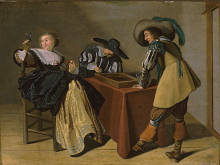
Dirck Hals
c. 1660
Oil on panel, 24 x 35.5 cm.
Muzeum Narodowe, Warsaw
Challenged by the unrivaled atmospheric effects and masterful application of perspective achieved by the Delft church painters, Pieter de Hooch (1629–1684) (fig. 12) and Vermeer soon brought to the domestic interior motif an unprecedented level of spatial coherence, of which perspective was a main concern. Both De Hooch and Vermeer would employ distance points equidistant from the central vanishing point to establish the patterns of their tiled floors, adjusting the distance points to alter the rapidity of spatial recession. De Hooch, despite being less talented than Vermeer, seems to have attained a command of perspective somewhat sooner than Vermeer.Jørgen Wadum, "Vermeer in Perspective," in Johannes Vermeer, eds. Arthur K. Wheelock Jr. and Ben Broos (London and New Haven: Yale University Press, 1995), 74. The fact that De Hooch's father was a bricklayer, who certainly would have had a mason's command of practical geometry, may explain why he initially outpaced Vermeer in this discipline.
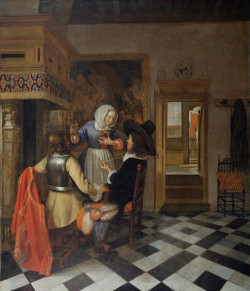
Hendrick van der Burch
c. 1660
Oil on canvas, 77.47 x 66.36 cm.
Frick Collection, New York
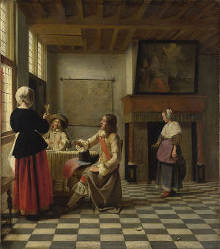
Pieter de Hooch
c. 1658
Oil on canvas, 73.7 x 64.6 cm.
National Gallery, London
In fact, it was commonly stated that mastering perspective required above all the need for practical experimentation. In the preface of his treatise on perspective, for example, Girard Desargues (1591–1661), the French mathematician and engineer considered one of the founders of projective geometry, recommended consulting surveyors, carpenters, bricklayers and cabinetmakers to learn the meetkunst (geometry) that was the basis for doorsicht-kunde (perspective). "The architectural painter Pieter Jansz. Saenredam (1597–1665) acquired his first instruction in the rules of perspective from the local landmeeter (cartographer). In Haarlem this profession was included in the painter's guild of Saint Luke, and also in Delft one could receive education in this metier. At the age of thirty-six Anthony van Leeuwenhoek, who may have known Vermeer personally, obtained his diploma in cartography in Delft—that is, when Vermeer had already made a number of 'perspectives.'"Walter Liedtke, "Saenredam's Space," Oud Holland 86 (1971): 121. Rather than an isolated development in painting, linear perspective sat at the confluence of the fields of geometry, optics and land surveying as well as the emerging field of cartography.
For a complete list of pre-1900 perspective manuals (with subsequent republishings) consult the Russell Light's excellent PERSPECTIVE RESOURCES, from which the list below was derived.
Click on the links below to access PDF files of the treastises.
- ALBERTI, Leon (1435) - De Pictura.
* Italian translation - Della Pittura, 1436. First published editions: Latin - Basel, 1540; Italian - Venice, 1547; English (trans. from Italian) - Leoni, 1726. - FILARETI (c.1461–1464) - Libro Architettonico, (later referred to as the Trattato…)
- P. DELLA FRANCESCA (c.1470) - De Prospectiva Pingendi, critical edition ed. G Nicco-Fasola, Florence, 1942.
- DA VINCI (c. 1500–1518) - Notebooks
- VIATOR (Pèlerin, Jean) (23 June, 1505) - De Artificiali P(er)spectiva, Toul, Petrus Jacobi.
- DÜRER, Albrecht (1525) - Unterweisung in der Messung mit Zirkel und Richtscheit (Measurement by Compass and Ruler).
- SERLIO, Sebastiano (1537–1547) - Tutte l'Opera d'Architectura et Prospettiva, Venice.
- ARETINO, Pietro (1557) - Dialogo della Pittura di M. Lodovico Dolce initolato l'Aretino, Venice.
- COUSIN, Jean (1560) - Livre de Perspective, Paris, Jean le Royer.
- BARTOLI, Cosimo (1564) - Del Modo di Misurare le Distantie, le Superficie, i Corpi, le Piante, le Provincie, le Prospettiue, & Tutte le Altre Cose Terrene, Venice, Francesco Franceschi.
- BARBARO, Daniele (1568) - La Practica della Perspettiva di Monsignor Daniele Barbaro Eletto Patriarca d'Aquileia, Opera Molto Utile a Pittori, a Scultori, & ad Architetti, Venice, Camillo and Rutilio Borgominieri.
- JAMITZER, Wenzel (1568) - Perspectiva Corporum Regularium, Nurnberg, Gotlicher Hulff.
- BASSI, Martini (1572) - Dispareri in Materia d'Architettura, et Perspettiva. Con Pareri di Eccellenti, et Famosi Architetti, chi li Risoluono, Brescia, Francesco and Pietro Maria Marchetti.
- DU CERCEAU THE ELDER, Jacques Androuet (1576) - Leçons de Perspective Positive, Paris, Mamert Patisson.
- VIGNOLA, Jacopo Barozzi da (1583) - La Due Regole della Prospettiva di M. Iacomo Barozzi da Vignola con i Comentarij del R.P.M. Egnatio Danti, Rome.
- VILLAFANE, Ioan de Arphe y (1585) - De Varia Commensuracion para la Escultura, y Arquitectura, Seville, Andrea Pescioni y Ivan de Leon.
- SIRIGATTI, Lorenzo (28 October, 1596) - La Practica di Prospettiva, Venice, Girolamo Franceschi. (Eng. ed., Issac Ware, 1756)
- DEL MONTE, Guido Ubaldo (1600) - Perspectivae Libri Sex, Pesaro, Hieronymus Concordia.
- DE VRIES, Hans Vredeman (1604–1605) - Perspectiva, id est Celeberrima ars Inspicientis aut Transpicientis Oculorum Aciei, in Pariete, Tabula aut Tela Depicta, The Hague, Leyden.
- HONDIUS, Hendrik (1622) - Onderwysinge in de Perspective Conste, The Hague, Hondius.
* (1622) - Institutio Artis Perspectivae.
* (1625) - Instruction en la Science de Perspective.
* (1640) - Gondige Onderrichtinge in de Optica, oft Perspective Konst, Amsterdam. - ACCOLTI, Pietro (1625) - Lo Inganno de Gl'ochi, Prospettiva Practica, Florence, Pietro Cecconcelli.
- VAULEZARD, I.L. de (1630) - Perspective Cilindrique et Conique; ou Traité des Apparences Vues par le Moyen des Miroirs Cilindrique et Conique, Paris, J. Jacquin.
- DESARGUES, Girard (1636) - Example d'une des Manières Universelles, Paris, the author.
- NICERON, Jean François (1638) - La Perspective Curieuse, ou Magie Artificielle des Effets Merveilleux de l'Optique…la Catoprique…la Dioptique, Paris, Pierre Bilain.
- DUBREUIL, Jean (1642) - La Perspective Practique…par un Parisien, Religieux de la Compagnie de Iesus, Paris, Melchior and François Langlois.
- ALÉAUME and MIGON (1643) - La Perspective Spéculative et Pratique du Sieur Aléaume, ed. by Etienne Migon, Paris.
- BOSSE, Abraham (1648) - Manière Universelle de Mr Desargues pour Pratiquer la Perspective par Petit-Pied, comme le Géometral, Paris, the author.
- LECLERC, Sébastien (1669) - Practique de la Géométrie sur le Papier et sur le Terrain, Paris, Thomas Jolly.
- TROILI, Giulio (1672) - Paradossi per Pratticare la Prospettiva, senza Saperla, Fiori, per Facilitare l'Intelligenza, Frutti, per non Operare alla Cieca, Bologna, heirs of Peri.
- POZZO, Andrea (1693–1700) - Perspectiva Pictorum et Architectorum Andreae Pozzo Putei e Societate Jesu, Rome, Joannis Komarek Bohemi.
- LAMY, Bernard (26 February, 1701) - Traité de Perspective, ou sont Contenus les Fondamens de la Peinture, Paris, Anisson.
- BIBIENA, Ferdinando Galli (1711) - L'architettura Civile Preparate su la Geometria, e Ridotta alle Prospettive, Parma, P. Monti.
- TAYLOR, Brook (1715) - Linear Perspective: or, a New Method of Representing justly All Manner of Objects as They Appear to the Eye in all Situations, London, R. Knaplock.
- Cone of Vision (COV): The area of vision that emanates from our eyes is about 60 degrees wide, before distortion begins to affect what we see. Outside of the 60-degree angle, objects begin to blur. In linear perspective, the Cone of Vision is indicated with a 60-degree angle beginning at the station point; it is 30 degrees to the left and right of the line of sight.
- Distance Points & Distance Lines: The two vanishing points on the horizon, at which diagonal 45-degree lines in the horizontal plane meet, are known as distance points. They are the same distance from the central vanishing point as the viewer is from the picture plane. If, within a picture, a horizontal square parallel to the picture plane can be identified, extending the diagonals to the horizon will give the distance points. The distance of the viewer to the picture plane is then known, and it becomes possible, by working backwards, to create a plan of the space within the picture.
- It is debatable whether the correct viewing distance was of any importance to the early users of perspective. In reality, however, there are paintings that show an approach that could not be considered to be purely Albertian. Many paintings show a floor grid with a recession that appears to be governed solely by the 45-degree diagonals of the grid squares being drawn towards a point at eye level, often placed at the edge of the painting. This approach is often referred to as the "distance point" method, and these points are known as "distance points" simply because the distance between them and the central vanishing point is the same as the distance between the viewer and the picture plane. It follows that if the vanishing point for the orthogonals is placed centrally, and the edge of the painting is used as a distance point, then the "correct" viewing distance is half the width of the painting. It also follows that the angle of view is 90 degrees. It has been generally assumed that these points have been placed at the edge of the paintings for completely practical reasons.
- We do not know the precise moment at which the two lateral points received their theoretical explanation as the "point of distance." We do not know if Brunelleschi understood that their distance from the central vanishing point represented, according to the scale of the picture, the distance between the vantage point of an ideal spectator and the plane of the image.
- Field of Vision (FOV): The area wider than the Cone of Vision, extending out from the viewer at 90˚, is where distortion begins.
- Converging Lines: In perspective drawing, parallel lines converge towards a single vanishing point.
- Diminishing Forms or Diminution: Refers to the apparent size of objects and how they become smaller as the distance between the object and the viewer/artist increases; this is a key tenet of linear perspective.
- Foreshortening: Refers to the fact that although things may be the same size in reality, they appear to be smaller when farther away, and larger when close up. Foreshortening is often used in relation to a single object, or part of an object, rather than to a scene or group of objects.
- An excellent example of this type of foreshortening in painting is The Lamentation over the Dead Christ (c.1470–1480, Pinacoteca di Brera, in Milan), a work by Andrea Mantegna.
- Ground Line (G): A line drawn to establish the surface on which an object or objects rest; it is used to determine accurate vertical measurements in perspective drawings. The base or lower boundary of a picture plane. The term may also be applied to a similar construction line used anywhere in the picture to measure off points or to determine the scale of a figure.
- The ground line is always parallel to the horizon line. In perspective drawings that show top and side views, the side view of an object is placed on the ground line. It is usually the plane that is supporting the object depicted or the one on which the viewer stands.
- Horizon, Apparent Horizon, Visible Horizon, Skyline: The line at which the sky and Earth appear to meet. For observers near sea level, the difference between the geometrical horizon (which assumes a perfectly flat, infinite ground plane) and the true horizon (which assumes a spherical Earth surface) is imperceptible to the naked eye. For someone on a 1000-meter hill looking out to sea, the true horizon will be about a degree below a horizontal line.
- Horizon Line (HL): The actual horizon, where Earth and sky appear to meet, excluding obstructions like hills or mountains. In perspective drawing, the horizon is at the viewer's eye level. Artists tend to use the term "eye level," rather than "horizon," because in many pictures, the horizon is hidden by walls, buildings, trees, hills, etc. In perspective drawing, the curvature of the Earth is disregarded and the horizon is considered the theoretical line to which points on any horizontal plane converge (when projected onto the picture plane) as their distance from the observer increases.
- Lines above the horizon line always converge down to it; lines below always converge upward to it.
- Line of Sight: An imaginary line traveling from the eye of the viewer to infinity. In all paintings with perspective substructures, the line of sight is parallel to the ground. Lines which travel parallel to the line of sight are called orthogonals, which in a perspective drawing converge at the vanishing point.
- One-point Perspective: A drawing has one-point perspective when it contains only one vanishing point on the horizon line. This type of perspective is typically used for images of roads, railway tracks, hallways, or buildings viewed so that the front is directly facing the viewer. Any objects that are made up of lines either directly parallel with the viewer's line of sight or directly perpendicular (the railroad slats) can be represented with one-point perspective. These parallel lines converge at the vanishing point.
- One-point perspective exists when the picture plane is parallel to two axes of a rectilinear (or Cartesian) scene—a scene which is composed entirely of linear elements that intersect only at right angles. If one axis is parallel to the picture plane, then all elements are either parallel to the picture plane (either horizontally or vertically) or perpendicular to it. All elements that are perpendicular to the picture plane converge at the vanishing point.
- Orthogonal: Orthogonal is a term derived from mathematics. It means "at right angles" and is related to orthogonal projection, a method of drawing three-dimensional objects. Orthogonal lines are imaginary lines which are parallel to the ground plane and the line of sight of the viewer. They are usually formed by the straight edges of objects. Orthogonal move back from the picture plane. Orthogonal lines always appear to intersect at a vanishing point on the horizon line, or eye level. Although we do not generally note the convergence of orthogonal lines in real life, sometimes they become apparent when standing in the middle of a road, train tracks or on a long straight urban street.
- Perpendicular: At a right, or 90-degree angle to a given line or plane. An absolutely vertical line and an absolutely horizontal line are perpendicular to each other.
- Picture Plane (PP): In painting, photography, graphical perspective, and descriptive geometry, a picture plane is an imaginary plane located between the "eye point" (or oculus) and the object being viewed. It is typically coextensive with the material surface of the work and is ordinarily a vertical plane perpendicular to the sightline to the object of interest.
- Plane: In mathematics, a plane is a flat, two-dimensional surface that extends infinitely far. In colloquial language, it refers to any flat surface, such as a wall, floor, ceiling, or level field.
- Prospettiva: From the Latin "perspicere," meaning "to see distinctly."
- Projection: From the Latin "proicere," meaning "to throw ahead." A projection is a straight line drawn through different points of an object from a given point to an intersection with the plane of projection.
- Receding: Moving away from the viewer, the opposite of which is "Advancing."
- Station Point (SP or S): The position of the artist's eye relative to the object he or she is drawing. Sometimes referred to as "eye point," "point of view," or "viewpoint."
- Transversal: Transversal lines are lines that are parallel to the picture plane and to one another. They are always at right angles to orthogonal lines.
- Two-point Perspective: A drawing has two-point perspective when it contains two vanishing points on the horizon line. One point represents one set of parallel lines, the other point represents the other. Two-point perspective exists when the picture plane is parallel to a Cartesian scene in one axis but not to the other two axes.
- Vanishing Point (VP): Imaginary points on the horizon line in one- and two-point perspective where orthogonal lines receding into space appear to converge.
- Brook Taylor's "Linear Perspective: Or, a New Method of Representing Justly All Manner of Objects as They Appear to the Eye in All Situations" (1715) is said to have been the first to use the phrase "vanishing point."
- The Jesuit friar Andrea Pozzo, the author of "Perspectiva Pictorum et Architectorum" (1693–1700) and the monumental ceiling of Sant'Ignazio in Rome, was the first commentator to systematize the use of the "vanishing distance point" (punctum distantiae) to resolve a broad spectrum of perspective problems. He even anticipated the geometrical drawing technique from descriptive geometry by introducing the simultaneous use of plan and elevation to originate a detailed solution to the architectural ornamentation of the classical orders.
from: Bruce MacEvoy, "Two Point Perspective" 2015.
-
DEREGOWSKI JB, Parker DM. "On a changing perspective illusion within Vermeer's 'The Music Lesson'." Perception. 1988;17(1):13-21.
- GARCÍA-SALGADO, Tomás. "Some Perspective Considerations On Vermeer's 'The Music Lesson'," 2009.
- GARCÍA-SALGADO, Tomás. "The Music Lesson and its Reflected Perspective Image on the Mirror." Art+Math Proceedings, University of Boulder Colorado, 2005, 156–160.
- GARCÍA-SALGADO, Tomás. "Modular Perspective and Vermeer's Room." Bridges London (Conference Proceedings 2006, Editors: R. Sarhangi & J. Sharp)
- GUTRUF, Gerhard, and STACHEL, Hellmuth. "The Hidden Geometry in Vermeer's 'The Art of Painting,'" Journal for Geometry and Graphics vol. 14, no. 2 (2010): 187–202.
- GUTRUF, Gerhard, and Hellmuth STACHEL. "Reconstructing Vermeer’s Perspective in 'The Art of Painting'." Vienna; Vienna University of Technology. Retrieved October 22, 2023.
- HALLORAN, Thomas O. "Reconstructing the Space, in Vermeer's 'Officer and Laughing Girl,'" Anistorian: In Situ, vol. 8, September 2004.
- HEUER, Christopher. "Perspective as Process in Vermeer," Anthropology and Aesthetics no. 38 (Autumn, 2000) 82–99.
- LORDICK, Daniel. "Parametric Reconstruction of the Space in Vermeer's Painting 'Girl Reading a Letter at an Open Window'," Journal for Geometry and Graphics, Volume 16 (2012), No. 1, 69–79.
- JOHNSON, C. Richard, Jr. and SETHARES, William A., with contributions by: FRANKEN, Michiel, JOHNSON, C. Richard, Jr, NOBLE, Petria, SETHARES, William
- KOBAYASHI-SATO, Yoriko. "Vermeer and his Thematic Use of Perspective," Amsterdam. In his Milieu: Essays on Netherlandish Art, in Memory of John Michael Montias, 2009, 212.
- LEE, Yiwei Christina and CHEW, Mei Ru Madeleine. "The Length of Vermeer's Studio"
- LIVIANDI, Aditya. "Reconstruction of Vermeer's 'Music Lesson': An application of Projective Geometry"
- STEADMAN, Philip. Vermeer's Camera: Uncovering the Truth behind the Masterpieces. Oxford: Oxford University Press, 2001.
- STEADMAN, Philip. Vermeer's Camera. 2001.
- A., STOLWIJK, Chris, VERSLYPE, Ige, WEIDEMA, Sytske and WHEELOCK, Arthur K., Jr. "Optical Devices, Pinholes and Perspective Lines," Counting Vermeer: Using Weave Maps to Study Vermeer's Canvases. RKD Monographs, 2018.
- WADUM, Jørgen. "Vermeer in Perspective," in exh. cat. Johannes Vermeer. National Gallery of Art, Washington, D.C. Royal Cabinet of Pictures Mauritshuis, The Hague (1995–1996), 67–79.
- WADUM, Jørgen. 1995. "Johannes Vermeer (1632-1675) and His Use of Perspective." In Historical Painting Techniques, Materials, and Studio Practice, edited by Arie Wallert and Erma Hermens, 148-154.
- WADUM, Jørgen. "Vermeer and Spatial Illusion," in The Scholarly World of Vermeer. Waanders Publishers, Zwolle, 1996, 31–50.
- WALD, Robert. "The Art of Painting': Observations on Approach and Technique," in Vermeer: Die Malkunst, edited by Sabine Haag, Elke Oberthaler and Sabine Pénnot, Kunsthistorisches Museum, Vienna: Residenz, 2010, 314.
Reconstructing Vermeer's Perspective Methods
Please note that the links to Vermeer's paintings below lead to the interactive catalogue entries. Perspective diagram of each work can be accessed by clicking here.
In Vermeer's 25-or-so interior paintings scarcely a sign of mathematical working has been so far detected. In a recent technical examination of The Art of Painting, one of the artist's most challenging perspectives, neither perspective lines drawn on or scored into the preparatory grounds nor "persepctive pentimenti" have been found, to say nothing of the complex network of construction linesSuch evidence is routinely produced by means of a high-resolution microscope, or X-ray or infrared reflectogram imaging. associated with the elaborate architectural perspectives of Saenredam or Bartholomeus van Bassen (1590–1652). This suggests that Vermeer solved perspective-related problems before he began to paint.
Given the accuracy of Vermeer's mature perspectives it can be safely ruled out that he devised them uniquely via free-hand drawing, no matter how sensitive his eye and skilled his hand might have been. Without any sort of guide or measuring tool (e.g., rulers, straight edges, compasses, projectors or tracing devices) registering the foreshortening of the tiny intervals between the intricate window fixtures or the angles of the diagonally set floor tiles so precisely that they could be used to generate geometrically correct vanishing points is beyond the capabilities of even the most consummate draftsman. While a trained artist may be able to distinguish very slight deviances from a perfectly vertical or horizontal line, assessing intermediate angles by eyesight and reproducing them on a flat surface is altogether another problem. A simple straight edge might have helped to maintain regularity, but not much more than that. Proceeding by eye alone, slight mismeasurements will gradually accumulate and eventually yield perspective lines that converge at relatively random points, making an estimate of the indispensable vanishing and distance points a matter of serious guesswork. However, it cannot be completely ruled out that such a skilled artist as Vermeer may have first made the most accurate free-hand drawing possible, afterward conforming it to the central vanishing and distance points of linear perspective in order achieve a higher level geometric coherence in both the whole and its parts. Walter Liedtke believed that Saenredam followed this practice.Walter Liedtke, "Saenredam's Space," Oud Holland 86 (1971): 121. Unfortunately, since not a single drawing by Vermeer has survived it is impossible to assess his prowess as draftsman, but given the exceptional level of brush control starkly evident in his mature works his drawing skills may have been exceptional.
It has been variously hypothesized that Vermeer developed his perspectives with one of four methods: geometric construction, the drawing frame, the pin-and-string method or the camera obscura, although strictly speaking some of these methods are not mutually exclusive. For example, the concepts of geometric construction may be applied to a perspective drawing made with a drawing frame or a camera obscura in order to bring it into proper perspective. In any case, each of the above methods has its advantages and disadvantages which, naturally, depend to a notable degree upon the goals, inclination and skill set of the painter who adopts them. Whereas many artists are oppressed by the tedium of geometric construction and find it alien to the creative process, the Dutch and Flemish perspective painters must have spent many hours wielding rulers and compasses. The subject matter of these works are (geometrically) much more complicated than those of Vermeer, but, nonetheless utilize the same basic principles.
In any case, we can safely assume that artists were not dogmatic with regards to their methods and tools. Determining the viability of one tool or technique as opposed to another was dictated by eminently practical concerns, probably, on a case-by-case basis. Thus, it would seem only logical that since Vermeer's perspectives vary considerably in theoretical and practical complexity, he may have employed whatever technique, or combination of techniques, which he felt most convenient for the specific task at hand, following the path of least resistance, as artists are want to do.
The following considerations are based on the assumption that Vermeer's paintings represent, rather than found or fantasy situations, contrived constructs that were realized by composing real objects in carefully lit spaces with real furniture, decorations and costumed sitters. This seems probable not only for the extraordinary exactitude of detail and astounding effects of daylight characteristic of his paintings, but for the correctness in proportion of the aggregate whole and the dimensional cross consistency (as demonstrated by Steadman) of a group of props and architectural elements, as well as dimensional consistency with corresponding objects preserved in museums.
LOOKING OVER VERMEER'S SHOULDER
The complete book about Johannes Vermeer's and 17th-century fine-painting techniques and materials
by Jonathan Janson | 2020
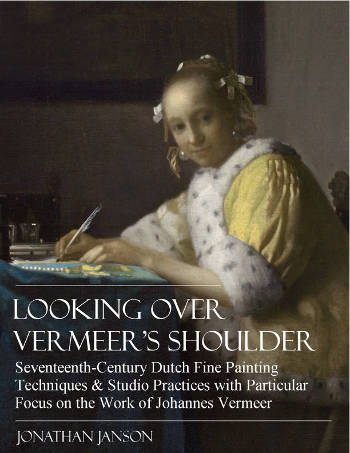
Enhanced by the author's dual expertise as both a seasoned painter and a renowned authority on Vermeer, Looking Over Vermeer's Shoulder offers an in-depth exploration of the artistic techniques and practices that elevated Vermeer to legendary status in the art world. The book meticulously delves into every aspect of 17th-century painting, from the initial canvas preparation to the details of underdrawing, underpainting, finishing touches, and glazing, as well as nuances in palette, brushwork, pigments, and compositional strategy. All of these facets are articulated in an accessible and lucid manner.
Furthermore, the book examines Vermeer's unique approach to various artistic elements and studio practices. These include his innovative use of the camera obscura, the intricacies of his studio setup, and his representation of his favorite motifs subjects, such as wall maps, floor tiles, and "pictures within pictures."
By observing closely the studio practices of Vermeer and his preeminent contemporaries, the reader will acquire a concrete understanding of 17th-century painting methods and materials and gain a fresh view of Vermeer's 35 masterworks, which reveal a seamless unity of craft and poetry.
While the book is not structured as a step-by-step instructional guide, it serves as an invaluable resource for realist painters seeking to enhance their own craft. The technical insights offered are highly adaptable, offering a wealth of knowledge that can be applied to a broad range of figurative painting styles.
LOOKING OVER VERMEER'S SHOULDER
author: Jonathan Janson
date: 2020 (second edition)
pages: 294
illustrations: 200-plus illustrations and diagrams
formats: PDF
$29.95
CONTENTS
- Vermeer's Training, Technical Background & Ambitions
- An Overview of Vermeer’s Technical & Stylistic Evolution
- Fame, Originality & Subject Matte
- Reality or Illusion: Did Vermeer’s Interiors ever Exist?
- Color
- Composition
- Mimesi & Illusionism
- Perspective
- Camera Obscura Vision
- Light & Modeling
- Studio
- Four Essential Motifs in Vermeer’s Oeuvre
- Drapery
- Painting Flesh
- Canvas
- Grounding
- “Inventing,” or Underdrawing
- “Dead-Coloring,” or Underpainting
- “Working-up,” or Finishing
- Glazing
- Mediums, Binders & Varnishes
- Paint Application & Consistency
- Pigments, Paints & Palettes
- Brushes & Brushwork
Geometrical Construction
Vredeman de Vries
Published: The Hague, 1604–1605
The level of conceptual sophistication of Vermeer's perspectives varies greatly from painting to painting. Works such as Woman in Blue Reading a Letter, Maid and Mistress and A Lady Writing would require little more than the awareness that lines and straight edges parallel to the viewer's line of sight converge at a single point located at the eye level, something every competent painter in the Netherlands was aware of. However, for the more complex pictures a deeper knowledge was indispensable. In theory, at least, it would have been possible for Vermeer to have devised multi-point perspective frameworks of his interior scenes by means of geometric construction.
Although geometric construction is particularly suited for foreshortening geometrically shaped objects, especially those with straight edges, some perspective treatises offered elaborate explanations how perspective could be applied to the human figure (fig. 13) or even determine the shapes of cast shadows. Some instructed the artist how to represent even the most complicated objects and architectural ornaments with mathematical precision.
Geometric construction involves creating a kind of "stage" from a plan (i.e., overhead view) and elevation (i.e., side view) by which objects can be positioned and brought into correct foreshortening (fig. 14). The construction would have been done on paper rather than on canvas because errors can be more easily fixed and if needed the original drawing can be expanded to greater dimensions by simply attaching other sheets of paper.
Jean Cousin
1560
published by Royer, Paris
It is often written that the plan and elevation technique was an important ingredient in the descriptive geometry created by Gaspard Monge in the late 1760s. However, some of the elements of descriptive geometry are already to be found in Albrecht Dürer's Unterweisung in der Messung mit Zirkel und Richtscheit (1525), and about half a century earlier Piero della Francesca used the same technique. "In the hands of the major theorist of perspective in France, Jean Cousin, perspective became a reliable, comprehensive and substantially accurate method for tackling the construction of space and the foreshortening of solid bodies. In the Livre de perspective published in Paris in 1560, Cousin established a method of constructing a foreshortened ground plan on which solid bodies can be built in an accurately geometrical manner, achieving complex results by basically simple means. He also realized that sets of parallel lines which are neither at right angles nor at 45 degrees to the picture plane converge to their own 'accidental' points (poinct accidental)."Martin Kemp, The Science of Art: Optical Themes in Western Art from Brunelleschi to Seurat (New Haven: Yale University Press, 1992), 66–67. Of course, we do not know if Vermeer had access to Cousin's text, which was more advanced than anything found in any other published text from this period, or even if he would have found it too mathematically oriented for his purposes.
It is important to understand that the plan and elevation procedure allows the painter to create imaginary perspectives from scratch, but also to derive perspectives of extant buildings or interior environments from actual measurements, seen from any height and distance. In the case of at least one Dutch painter, Saenredam, hard evidence has survived revealing how plan and elevation construction was used to create the perspectives of real buildings. Saenredam made "countless measurements of the church interiors, recording various details in smaller drawings, and occasionally in large ground plans. There must have been dozens of these kinds of drawings, though now we have but 15, including four ground plans. He began his composition drawings by establishing the so-called 'eye,' the point on the horizon line that indicated his eye level while drawing. This was directly opposite the draughtsman's vantage point. He denoted the 'eye' with a dot and circle, sometimes writing it next to it (oogh), and sometimes its height from the ground.."Arie de Groot et al, Pieter Saenredam, The Utrecht Work: Paintings and Drawings by the 17th-century Master of Perspective (Los Angeles: The J. Paul Getty Museum, 2000).
In order to create an accurate perspective of a domestic environment by means of geometrical construction, it is first necessary to make measurements of its architectural features and furnishings and choose the distance and height from which the scene will be viewed.In the simplest terms, if one were to know that a one-by-one-meter wooden box were set on the ground perpendicularly to the viewer's line of sight at a distance of five meters and one meter to the right, and that the viewer's eyes were set one and a half meters from the ground, in short time even an artist discreetly informed about perspective could develop a mathematically correct drawing of how the box would appear in spatial three-dimensions. These measurements are scaled down to the desired dimension and then used to develop plan and elevation diagrams of the room and the objects it contains in their appropriate positions and angles with respect to the viewer. Subsequently, the architectural environment and objects within it must be slowly worked into perspective following a chain of complicated geometrical calculations, of which only the very broadest are outlined below.
Once the vanishing point and the distance points are known, the foreshortening of the geometrically shaped objects set perpendicularly to the viewer's line of sight (e.g., floor tiles, rafters, tables, chairs and windows) can be developed into a one-point perspective drawing by means of traversals and converging orthogonals.Since we have no way of gauging the position or dimensions of the hanging curtains, there would be little to gain by developing them in perspective. It would also make little sense to use perspective to create figures, drapery, or irregularly folded carpets.Lines issuing from the distance points, instead, allow the artist to define the shapes of the obliquely set floor tiles and subsequently determine the foreshortened shapes of objects set a 45 degrees angle to the viewer's line of sight. The London architect Philip Steadman (Vermeer's Camera: Uncovering the Truth behind the Masterpieces, 2001) discovered that not only did Vermeer employ one- and two-point perspective simultaneously in a geometrically correct manner, but evidence that the artist was aware of the relationship between the actual distance from the viewer to the picture plane (fig. 15), and the distance between the central vanishing point and the distance points, although we cannot ultimately determine if the latter understanding was fruit of theoretical inquiry or the elaboration of empirically based evidence.


Vredeman de Vries
Published: The Hague, 1604–1605
In any event, the fact that the distance points in Vermeer's perspectives are correctly calculated is noteworthy because they are crucial for creating a natural sensation of spatial recession, which can be said to be a distinguishing characteristic of his mature interiors. Distance points allow for the determination of depth, height and all other features of the illusory space to be represented with respect to a real, known distance from which the view observes his subject. Increased distance between the distance points and the central vanishing point corresponds to increased observer distance from the picture plane, and vice versa. Nonetheless, it is "debatable whether calculating the correct viewing distance was of any importance to he earliest users of perspective, [as well as to many seventeenth-century Dutch painters]. Early renaissance paintings, for example, show a floor grid with a recession that appears to be governed solely by the 45 degrees diagonals of the grid squares being drawn towards a point at eye level, often placed at the edge of the painting, perhaps for completely practical reasons."Bruce Macao, "Two Point Perspective," 2015. https://www.handprint.com/HP/WCL/perspect3.html. Richard Talbot noted that "It has been generally assumed that distance points have been placed at the edge of the paintings for completely practical reasons. However, Alberti's description of the mechanics of the perspective construction is, in fact, slightly ambiguous and open to various interpretations. When two diagrams by Alberti are, in effect, overlaid, and under certain circumstances, when the picture plane is placed down the center of the painting, would result in the distance point and the viewer's position coinciding. The particular properties and wider implications of this construction, however, appear to have gone unnoticed." Richard Talbot, "Speculations on the Origins of Linear Perspective: Including Analyses of Masaccio's Trinity and Piero's Flagellation," Nexus Network Journal, vol. 5, no. 1 (2003): 67–68. Even Vredeman de Vries, and a number of seventeenth-century Dutch interior painters, made the mistake of placing the distance points at the edges of the visible picture (fig. 16) causing an unnatural, funnel-like recession. However, it cannot be ruled out that Vredeman de Vries, and other practitioners of perspective who made the same "error," found this effect to their liking, showcasing the artist's ability to overwhelm the spectator's senses.
The only painter who is documented to have used measurements to throw extant buildings into perspective via a distance point method is Saenredam. Bob RurrsRob Ruurs, Saenredam: The Art of Perspective (Amsterdam: John Benjamins Publishing Company, 1987), 90–91. noted that, despite his significant personal library, the Haarlem-based church painter owned only two books on perspective, one by Serlio the other by Dürer, but found that Serlio's text did not discuss the distance point method while Dürer described it in an "almost incomprehensible and partially incorrect" manner. In fact, Ruurs advanced that the knowledge necessary for describing how the real-life distance between the artist's eye and a particular point of his subject can be converted into a corresponding distance on a drawing could not be found in a complete form in any single work which would have been available to Saenredam. Thus, according to Ruurs, Saenredam "must have had the assistance from one or more men who were capable of independent mathematical thinking to develop suitable construction." Ruurs further notes that the lack of a comprehensive distance point method was due to the fact that until Saenredam came along, there was simply no use for a technique for constructing extant architectural forms from measurements because from the Renaissance onward perspective had been used only to create fictitious architectural settings, rather than portrayals of real buildings. Kemp confirms that, in effect, "painters were not employed to paint townscapes as such, except in very unusual circumstances, and a set of existing buildings is unlikely to have provided an appropriate or adaptable setting for the religious subject matter which predominated. The sheer effort involved in making a projection of a given building must have seemed to promise little or nothing which their existing methods could not serve more effectively, adaptably and economically. What was needed was a means of adapting Brunelleschi's procedures to the creation of an imagined space which could act as the servant to the artists' needs."Martin Kemp, The Science of Art: Optical Themes in Western Art from Brunelleschi to Seurat (Yale University Press: New Haven, 1992), 15. Thus, in the case Vermeer had indeed used a combination of geometric construction and some sort of a distance point method to create his perspectives as Saenredam had apparently learned to do, he would have most likely acquired this knowledge via experimentation, personal communication with someone particularly well versed in this field or a combination of the two.
The foreshortening of some of the simplest symmetrically shaped objects (e.g., wine pitchers, wine glasses, or roemers) could have been created via geometric construction, but it would have no doubt been much less wearisome for a skilled painter to draw such objects free-hand, once their relative positions and dimensions on the picture plane had been calculated. Minor irregularities and decorative embellishments would also be drawn free-hand, with the finest details introduced at the last moment, if not postponed to the actual painting phase. Obviously, nothing could be gained by developing perspective models for drapery or human figures (except for their heights). An experienced draftsman would have encountered no great problem integrating hand-drawn figures within the basic perspectival framework.Architectural painters frequently inserted auxiliary figures, called staffage, in their pictures once the architectural features had been completely depicted. One particular work by De Hooch displays pentimenti of floor tiles beneath the figures indicating that the artist had developed the perspective of the floor tiles before painting the figures. More complicated objects might have necessitated the use of linear perspective.
It is interesting to note that in his widely consulted perspective treatise, the Italian architect Lorenzo Sirigatti (1596–1625) found that a few dozen correctly plotted points were sufficient to designate the basic structure of a foreshortened bass viol or a lute (fig. 17), which at the time were deemed among the most challenging objects to draw correctly. Sirigatti evidently assumed that a practiced draftsman, like himself, would have had no problem connecting these points to form the instrument's smooth curves.
Perspective contenant la. theorie pratique et instruction fondamentale d 'icelle
Samuel Marolois
1628
In order to foreshorten objects set at 45 degrees to the viewer's line of sight (e.g., tiles, tables (fig. 18), chairs (fig. 19) and stools) a relatively sophisticated understanding of two-point perspective is necessary. For example, the construction lines needed to describe the top and bottom edges of a cube rotated 45 degrees to the viewer's line of sight will converge at the distance points previously positioned equidistant from the central vanishing point. However, objects which are rotated at intermediate angles, such as the foreground chairs of The Glass of Wine or The Concert, require calculating a separate set vanishing points, or "accidental points" as they were called the few times they were mentioned in perspective literature. For example, if the same cube were to be a rotated a bit clockwise, the left-hand lines will converge at a point closer to the central vanishing point whereas those of the right-hand side would converge at a greater distance. The forward faces of objects set almost but not quite perpendicularly to the viewer's line of sight, such as the open window in Vermeer's Woman with a Water Pitcher, produce very long distance lines that converge at a point far from the picture's perimeter. The exact relationship between the angle of the object and the space between the distance points and the central vanishing point of these kind of objects is governed by trigonometric principles—in order to project them correctly a painter would have needed a particularly inquisitive mind as well as a firm grip on the rules of geometrical construction, or at least have access to Cousin's treatise and have been capable of applying its lessons to actual circumstances.
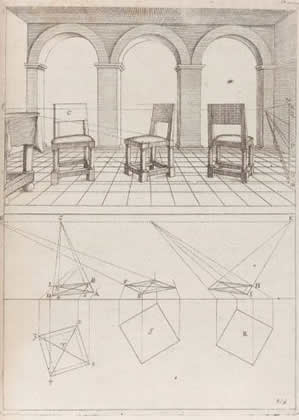
Jean Dubreuil
1642
In Vermeer's paintings there are a number of instances in which the points where a movable object meet the pavement are located off the painting's surface, for example, the foreground chair and table of The Art of Painting. In these cases it would have been necessary to create a perspective drawing large enough to encompass the complete object, including where its missing parts touch the gridded pavement, otherwise they could not be correctly constructed. Since we have no way of reconstructing such objects via reverse geometry, it is impossible to verify if their measurements comply to those of similar objects in other pictures or with known objects in museums.
Despite the fact that constructing a complex perspective drawing ground-up from measurements would require unwavering commitment, two contemporary interior paintings— The Chess Players (fig. 20) and The Goldweigher (fig. 21) by Cornelis de Man (1621–1706)—provide indisputable evidence that in Delft, where Vermeer lived and worked, the knowledge needed to produce geometrically rigorous perspectives of a seemingly extant domestic environments was indeed available.The extraordinary accuracy of De Man's perspectives was brought to my notice in personal communications with Craig McDonough. In any case, the artist's command of perspective was probably acquired through his experience as an architectural painter. The construction lines of The Chess Players all lead to their appropriate vanishing and distance points with notable precision. The only systematic error in The Goldweigher is that vanishing lines of the black chest, which may have been added at the last moment to cover up the distortions of the corner floor tile, do not converge upon the horizon line but far above it.
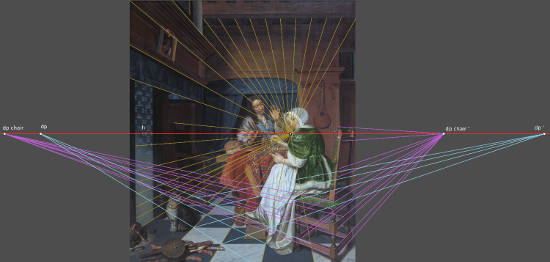
Cornelis de Man
c. 1670
Oil on canvas, 97.5 x 85 cm.
Szépművészeti Múzeum, Budapest

Cornelis de Man
c. 1670
Oil on canvas, 82 x 68 cm.
Private collection
Even if the spatial recession of both of De Man's paintings appears naively exaggerated, they are correct from a geometrical point of view, and indicate that the viewpoint was stationed very near the subject. Given that the same architectural elements appear in different interiors by De Man, it is conceivable that the artist had developed a set of measured drawings from which he could produce different perspective views,Personal communications with Philip Steadman. although it is not out of the question that he overlapped correct construction lines to carefully drawn preliminary sketches in order to achieve similar levels of precision. Whether De Man deliberately employed the close viewpoint to maximize the sensation of spatial recession or because his aim was to reconstruct an actual cramped environment—typical of real Dutch living conditions—as rigorously as possible cannot be determined. The broad, fish-eye effect of both works rules out that the artist utilized a camera obscura to develop either perspective. If the lens of a camera obscura had been placed at the painting's view point, a much smaller portion of the scene would have been projected on its screen.
It should not be lost on the reader that the two-point perspective view of De Man's The Goldweigher, whatever its purely artistic merit, requires greater competence in geometric construction than do the typically planar constructions of Vermeer.
The question of how one may determine to what extent one or another specific method of geometric perspective construction was used in any given painting is beyond the scope of the present study. This would require an exhaustive knowledge of perspective treatises and their diffusion, as well as an understanding of how a practicing seventeenth-century artist might have used them. But given that by 1650, when Vermeer was 18 years old, Houckgeest had solved perspective problems more challenging than anything we see in Vermeer's paintings, it may be assumed that Vermeer would have had access to the knowledge needed to create accurate geometrically based perspectives, whatever methods were employed.
As Steadman pointed out, "despite the fact that Vermeer's perspectives could [italics added] have been created with geometrical construction, there is no direct, positive evidence for this view, other than the geometrical correctness of his rendering. The existence of [accurately positioned] vanishing points and distance points in a perspective image is not in itself evidence that the artist has worked mathematically. A photograph of a comparable interior, viewed frontally, will have a vanishing point, a horizon line, and (if the floor has diagonal tiles) two distance points, in exactly the same way. So will an image traced in a camera obscura, or an image transcribed by means of a drawing frame."Philip Steadman, Vermeer's Camera: Uncovering the Truth behind the Masterpieces (Oxford: Oxford University Press, 2001), 152. Moreover, not a single measured drawing, written account (by Vermeer or others) or documented source that Vermeer studied or owned a perspective treatise has survived. Other than some ruled lines detected under the ceramic floor tiles of The Glass of Wine, construction lines drawn on or scored into the preparatory grounds of the canvases have not been discovered so far. Unfortunately, there is no historical evidence that Vermeer was willing or able to grapple with the intricacies of abstract geometry.
On the other hand Saenredam's personal library contained important tracts on mathematics and geometry, and various volumes by the Dutchman Simon Stevin (1548–1620), a Flemish mathematician, physicist and military engineer who wrote one of the most mathematically oriented texts on perspective of the time, Van de verschaeuwing (1605). Vermeer himself owned a number of books and folios, but, unfortunately, none of the titles or subject matter are known. We only know that Stevin gave a lecture in Delft, on geometry, but before Vermeer began to paint perspectives.
While it would have been relatively undemanding for an artist with in-depth knowledge of constructive geometry to develop the perpectives of Vermeer's simplest interiors, the main shortcoming of this method is that it would involve an enormous number of calculations for the most elaborate pictures, such as The Glass of Wine, Girl with a Wine Glass, The Art of Painting or The Music Lesson.
It should be remembered that although geometric construction may conceivably explain the accuracy of the perspectives of Vermeer's more complex compositions, it can in no way account for the precision in the drawing of the maze-like wallmaps, which have been found to correspond to know museum exemplars within a few percent of the originals. Such an astounding level or precision is, however, compatible with both the drawing frame and the camera obscura.
Drawing Frame
"Leon Battista Alberti's (1404–1472) geometric instructions to the artist may have been precise and systematic but their application still required a mathematical competence that exceeded most contemporary practitioners. Over the next few centuries, an array of techniques and devices were used to assist in the production of perspectivally accurate images."Antoine Bouquet, "The Perspectival Eye, Glass Bead," http://www.glass-bead.org/research-platform/the-perspectival-eye/?lang=en. One of the most popular was the drawing frame (fig. 22), originally conceived by Alberti himself.

Like the camera obscura, the drawing frameStrictly speaking, a drawing frame, or drawing machine, is different from a perspective machine. True perspective machines were more elaborate in structure and operation and were employed principally to demonstrate aspects of geometrical perspective. There is no evidence that they were used by practicing artists. allows the artist to transpose the contours of three-dimensional objects in three-dimensional space on a flat surface, as if they had been traced from a photograph. However, even though the underlying perspectives they produce are correct, neither of these devices directly produces any of the typical repertoire of perspective elements associated with geometrical construction—vanishing points, distance points, horizontal lines—but pure shapes, bounded by thin outlines. But in the case that these shapes are rendered with requisite precision, they can used to extract all of the common perspectival elements by a process called reverse perspective or reverse geometry.
In essence, both the drawing frame and the camera obscura allow the artist to return to what may be loosely defined as an oversized retinal impression, whose optical logic must be replicated in order to generate the perception of spatial depth on a two-dimensional surface, free from psychological and physiological interferences, known—and widely studied today—as perceptual constancies. Perceptual constancies are fundamental biological processes that allow us to identify objects and their locations in space under the highly varying conditions of nature with extraordinary efficiency, but they are the vexation of the advanced mimetic painter, who must somehow "undo" them in order to produce the effects of light, volume and space on a flat surface. The drawing frame enables the painter to tame two of the most powerful constancies: size constancy and shape constancy. Size constancy is the perception that a particular object's size will not appear to change, regardless of changes in distance from the viewer. Shape constancy, instead, is the tendency to perceive an object as having the same shape regardless of its orientation or the angle from which we view it. For example, when we look head-on at a rectangular picture frame hanging on the wall, it appears as a rectangle. If we walk off to the side and look at the frame from an angle, we still recognize that it's in the shape of a rectangle, although from that angle, the image processed by our retina is that of a trapezoid.
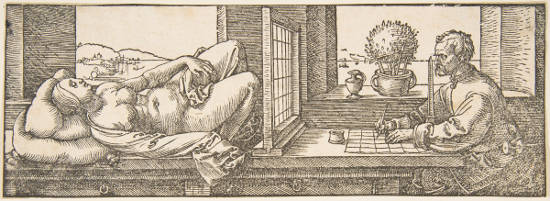
Albrecht Dürer
Woodcut, 7.7 x 21.4 cm.
c. 1600
Metropolitan Museum of Art, New York
Leonardo da Vinci
from: Codice Atlantico, f.1ra, c. 1480
Biblioteca Ambrosiana, Milan
By the time Vermeer began his career, the drawing frame had become a familiar instrument in painters' studios. It was composed of a wood frame, often with a pane of glass in it, and strings stretched at regular intervals both horizontally and vertically that create a grid of squares (fig. 23). In front of the upright frame is a vertical rod, whose length is equal to the distance from the base of the frame to the middle of the grid. By positioning one eye at the tip, the painter observes the scene from the same exact point of view, assuring that the perspective of his drawing will remain invariant.Early plans for drawing machines show the tip of the rod as a spike or point. But the point can be fitted with a ring because keeping the eye so close to a spike for long periods of time may be dangerous.
The origin of drawing frame is recorded in Alberti's De Pictura (1435). He describes it as "a veil (Italian: velo) of loosely woven fine thread, dyed whatever color you please, divided up by thicker threads into as many parallel square areas as you like, and stretched on a frame." In 1510, Leonardo da Vinci made a sketch of a draftsman drawing an armillary sphere (fig. 24) with an early drawing frame. Some of the most informative illustrations of this device were made by Dürer, who portrayed artists using it to draw a lute or the human figure (fig. 25 & 26),. It would seem that Dürer, like Leonardo, found the drawing frame particularly suited for solving the problems of localized foreshortening of complicated objects. Later illustrations show that it was considered equally useful for drawing broader views of nature (fig. 27 & 28), some that display regular architectural features typically associated with linear perspective (fig. 29).
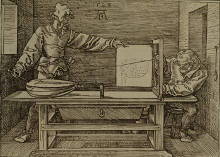 fig. 25 Man Drawing a Lute
fig. 25 Man Drawing a Lute Albrecht Dürer
1525
Woodcut, 5 1/8 x 7 3/16 in.
Metropolitan Museum of Art, New York
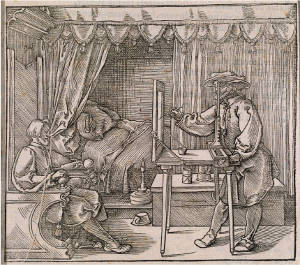
Albrecht Dürer
1532
Woodcut print on paper
Victoria and Albert Museum, London

Utriusque cosmi maioris scilicet et minoris metaphysica, physica atqve technica historia: in duo volumina secundum cosmi differentiam diuisa
Robert Fludd
1617
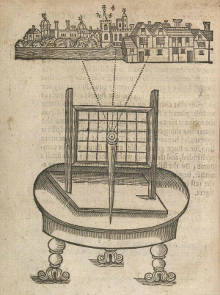
John Bates
1634
![from: La perspective pratique, necessaire a tous peintres, graveurs, sculpteurs, architectes, orphevres, brodeurs, tapissiers, […], Jean Dubreuil, 1642](images/drawing-frame-03-SML.jpg)
Jean Dubreuil
1642
Arnold Houbraken records that Gerrit Dou (1613–1675), Vermeer's close contemporary and competitor, "painted everything from life with the greatest accuracy and patience using a frame strung criss-cross with threads.""…Schilderboek ales met de garrotte Lynda, en gedult naar 't leven, door een met draden ruitswyze bespannen raam…" from: Jørgen Wadum, "Vermeer and spatial illusion," in The Scholarly World of Vermeer, Waanders: Zwolle, 1996, 36. Walter Liedtke has suggested that Houckgeest may have employed this type of device. The conservator Robert Wald mentioned the drawing frame as a possible explanation for the accuracy of Vermeer's perspectives, having in his opinion various advantages over camera obscuraRobert Wald, "'The Art of Painting': Observations on Approach and Technique," in Vermeer: Die Malkunst, ed. Sabine Haag, Elke Oberthaler and Sabine Pénnot (Kunsthistorisches Museum, Vienna: Residenz, 2010), 314. First, the painter's eyes do have to adjust to the dark space inside the camera obscura. The image seen through the drawing frame is neither dim nor upside down and backwards, and there are no problems associated with focus (i.e., depth of field) or lens distortion. Moreover, because the drawing machine frames the scene in a rectangle, it is, perhaps, more amenable to compositional organization than the upside down, unevenly focused image of the camera obscura. With respect to traditional mathematical constructions, the drawing frame, like the camera obscura, would free the artist from tedious mathematical calculations.
The device itself works like this. The artist places his eye at the tip of the rod, looks straight at the scene and draws what he sees bounded by the frame on a piece of paper that is gridded up with the same number of squares as in the frame. The grids makes it easy to see where each object is in relation to everything else. If, for example, Vermeer were to see the head of a figure in the middle of the fifth square up and the fourth square across, then he would draw it on the corresponding square of his paper. Obviously, the more squares are on the grid and paper, the greater precision is achieved, although if there are too many it is harder to tell which squares are being used. Some period illustrations show artists drawing directly on the glass with a fine-tipped brush. It may have been possible to somehow transfer the drawing on the glass to a sheet of paper or even directly to the canvas, although there is scarce evidence that artists actually used this method.
Using the drawing frame must have been somewhat tedious,"But if the artist found it hard to copy the proportions and perspective, he could transfer his outlines mechanically by pressing a sheet of paper against the glass to print off the greasy lines he had drawn there. and it was not universally approved. Alberti himself, wrote that there were "those who say it is no good for a painter to get into the habit of using these things, because, although they offer him the greatest help in painting, they render the artist unable to do anything without them." Samuel Hoogstraten (1627–1678) cursed the drawing frame and suggested using various drawing tools such as compass, most likely in reference to geometrical construction.
In any case, the drawing frame's development and diffusion made perspective more accessible to practitioners unschooled in the finer points of geometry. The range of applications widened outside the artistic field, notably in the military, with variants of grid or string methods and adaptations of the Jacob's staff, quadrant, or astrolabe, leading eventually to the photographic camera.
To understand if Vermeer could have used the drawing frame to develop his perspectives, various issues must be considered. To begin with, the fixed eye-point is absolutely essential. When utilized to draw scenes such as those of Vermeer, where an exceptionally high degree of precision is imperative for creating a functional perspective. Even the slightest movement of eye position causes the image to wobble dramatically with respect to the stationary strings of the frame. Some sort of mechanism would need to be devised in order to keep the artist's head absolutely immobile.
In the case that the eye position could be sufficiently stabilized, the ability to draw the scores of straight lines with the millimetric precision requisite to perspective drawings as complex as those of Vermeer may be hampered by other factors. If, for example, the painter opts for the glass method pictured in Dürer's A Draughtsman Drawing a Portrait, he cannot use a hard-tipped drawing instrument that would permit him to comfortably designate fine and perfectly even contour lines. Instead, he must use a long, but very flexible fine-tipped brush (a so-called "riggers" brush) imbibed with fluid paint. This specialist brush enables the artist to create long lines of breathtaking thinness without obligating him to continually pull its tip from the glass when there is no long sufficient paint draw. But to employ rigger's brush at full advantage, the painter to steady his hand on some sort of support, usually, a maulstick. Experienced painters know that a brush is much harder to control on a smooth panel than on the toothy surface of a canvas—the slippery surface of the glass would exacerbate the process. Furthermore, in the event that a satisfactory drawing could be made, how could it be transferred to the canvas or a master drawing?
No descriptions have come down from the earlier part of the seventeenth century that gives any helpful account of how the lines painted on the glass can be transferred to paper. But, in 1672, Dubreuil wrote that "one may mark on the Glass with a Pen and Ink, and after that all is done, to moisten a little the other side of the Glass for to refresh the Ink and to set of the side, which we have traced, a Paper somewhat moist, and then to pass the hand upon it; and the Paper will take, all that which was marked upon the Glass." We have no way of knowing if Dubreuil's devised what is essentially a printing technique himself but period technical manuals often reiterate commonly know facts along side the author's own inventions. The image however, will be reversed and in most cases a different dimension than that of the final artwork thus constrain the artist to take a further tedious steps. Another possible method consists in clamping a sheet of paper onto the drawn side of the glass, holding the it in front of a window allowing the painter to trace the lines he is able to see through the translucent paper.
If, on the other hand, the Albertian velo method is used, the back-and-forth transposition of the scene's contours as viewed through the frame to the squared paper, which involves no lack of guess-work, would probably diminish the level of precision with respect to that achieved with glass tracing. The squaring technique, for example, would not be adequate to measure the exact distances, often millimetric, between convergent and parallel lines which define of the various components of the windows, which in Vermeer's paintings are precisely calculated. However, if the artist were sufficiently learned in linear perspective it might have been possible to remanage the drawing and achieve the necessary level of precision.
In any case, only if the drawing frame is tested under systematic experimental conditions will its advantages and practical limits become sufficiently evident, and allow us to speculate if and how Vermeer might have used it. Moreover, like any mechanical or optical device, its practicality is based in significant part on the painter's artistic priorities and skill sets. What may be a useless or inhibiting process for one painter, may prove near providential to another.Robert Wald, "'The Art of Painting': Observations on Approach and Technique," in Vermeer: Die Malkunst, ed. Sabine Haag, Elke Oberthaler and Sabine Pénnot (Kunsthistorisches Museum, Vienna: Residenz, 2010), 314.
Pin-and-String
Like many European painters, Vermeer was not adverse to using mechanical tools as an aid to drawing. He used a compass to define the spherical body of the ceramic wine jug of The Procuress, evidenced by hole where the compass pierced the canvas at the jug's center, and scratches in the paint layer that conform to its outer contour.
(detail of the lady's bodice showing the presence of a pinhole at the center of the image)
Johannes Vermeer
c. 1670–1674
Oil on canvas, 51.7 x 45.2 cm.
National Gallery, London
To date, the only hard evidence telling us how Vermeer managed his perspectives regards the so called pin-and-string method, hypothesized by Jørgen Wadum.Jørgen Wadum, "Vermeer's Use of Perspective," in Historic Painting Techniques, Materials, and Studio Practice, Reprints of a Symposium Held at the University of Leiden, The Netherlands, 26–29 June 1995 (Santa Monica, 1995). This technique, of which there is no written documentation, consists in first inserting a pin into the canvas at the central vanishing point of the perspective. By attaching a string to the pin and pulling it taut, the correct orthogonals of a one-point perspective can be reached on any area of the canvas. The pin would have been firmly supported by a wood slat fixed to the back of the stretcher at a slight distance from the canvas (it is also possible, but unproven, that an analogous method could have been used in conjunction with the distance points). Since almost all of Vermeer's grounds contain lead white, the location of pin hole is revealed by a tiny dark spot on an x-ray photograph, resulting in the loss of minuscule amounts of paint and ground. X-radiographs can be used to find the black spot where the ground containing lead white is missing between the threads of the canvas. Evidence of 13 pin-holes in Vermeer's paintingsOfficer and Laughing Girl, The Milkmaid, The Glass of Wine, The Music Lesson, The Astronomer, The Geographer, The Art of Painting, The Love Letter, Woman Holding a Balance, Lady Writing a Letter with her Maid, Allegory of Faith, A Lady Standing at the Virginal, and A Lady Seated at the Virginal. have been detected. A barely detectable pin hole can be detected with the naked eye in various works (fig. 30).Woman Holding a Balance, The Art of Painting, Allegory of Faith. This method was used by both interior and architectural painters in Delft and elsewhere, and it is still used today by trompe-l'œil artists.
While there is no doubt that Vermeer used this trick systematically, there is serious debate as for what purpose he used it. While holding a chalked string taut between the pin in the vanishing point and the fingers of one hand, the artist's free hand could drawn the string up and let it snap back onto the surface, leaving a line of white chalk. This line could then have been traced with a pencil or brush. Wadum claims that this method was sufficient for constructing a perspective directly on the canvas, without resorting to any sort of mechanical device. Steadman, who champions the camera obscura as the most efficient solution to the problems of drawing and perspective, strongly objects to Wadum's claim. Even though the pin-and string method may be useful for drawing and rectifying orthogonals, Steadman maintains that it is utterly inadequate for constructing perspectives "as accomplished and accurate as Vermeer's undoubtedly are." In response to Wadum, Steadman wrote:
A pin and string provide no help in the central task: that of making perspective measurements. Wadum seems not to appreciate this point. Perhaps he has not himself set up measured perspectives on the drawing board. Vermeer depicts very many real pieces of furniture and other objects, in minute detail, at their actual known sizes. As regards the architecture of the room, he shows what is undoubtedly the same space (speaking in purely geometrical terms), with similar dimensions throughout, from ten slightly differing viewpoints. All this could not conceivably have been done freehand, even by the most skilled draughtsman. Nor could it have been done just with pins and string. Using standard mathematical construction methods would have required a set of carefully measured drawings (plans and side views) of the room and all the furniture, and a technique, involving literally thousands of construction lines, which carried all these measurements into the foreshortened images we see in the pictures themselves. Such a method is not impossible. Piero della Francesca did it in The Flagellation, and architects used to do it every day. [My] proposition is, of course, that all this perspective precision is a consequence of Vermeer having transcribed images from the camera obscura.Philip Steadman, "Vermeer's Camera: afterthoughts, and a reply to critics," http://www.vermeerscamera.co.uk/reply6.htm.

Jan Steen
c.1663–1666
Rijksmuseum, Amsterdam
The practicing painter Carsten Wirth echoes Steadman's objections when he writes, "If one selects as the point of departure for such a construction a puncture hole in a canvas, and the relatively uneven canvas as the medium for the drawing, in order to then reproduce a chain of complicated geometrical construction steps on the correspondingly small scale of Vermeer's pictures, which demand the highest precision, one must soon recognize that this is not practicable."Carsten Wirth, "The Camera Obscura as a Model of a New Concept of Mimesis in Seventeenth-Century Painting," in Lefèvre W., Inside the Camera Obscura—Optics and Art under the Spell of the Projected Image, Max-Planck-Institüt fur Wissenschaftgeschichte, Berlin, 192.
Although questionable as a means for constructing perspectives as elaborate as those of Vermeer's more ambitious compositions, the pin-and-string method would have proved helpful for creating basic orthogonals of the vast number of rudimentary perspectives such as Jan Steen's The Sick Woman (fig. 31). For the more sophisticated perspectives, the pin-and-string method would have allowed the painter to set a ruler against it—there is only evidence that Vermeer's used pin, not a string—and draw absolutely straight orthogonals and distance lines making them meet precisely at a single point. It would have also been useful to correct the inevitable imperfections that slowly creep in when the artist attempts to adhere to the ruled lines of his underdrawing with fluid paint and a flexible brush. For example, while painting the alternately colored floor tiles, whose tones, moreover, must gradually lighten or darken according to the amount of light each receives, the painter must focus his attention on rendering the edges of each single tile as straight and sharp as possible—no simple task in itself— while simultaneously maintaining perfect smoothness of the paint layer. Absorbed in this localized task it is easy to loose sight of the slight distortions that accumulate and gradually corrupt the straightness of the longer diagonals that divides the rows tiles from one another (i.e., the distance lines). By attaching a string to a pin located at one of the lateral distance points and pulling it taught over the distance lines the painter could easily discern where the edges need to be retouched. The same could be done with many of the architectural elements, including the horizontal lead muntins of the windows.
Camera Obscura
That a painter might have utilized the camera obscura as a shortcut for constructing perspectives may not be without precedent. As early as 1568, Daniele Barbaro (1513–1570), a Venetian patrician famous for his editions of the Roman architectural writer Vitruvius, had proposed explicitly that the camera may be used for producing drawings in correct perspective in his La pratica della perspettiva (The Practice of Perspective: 1568), one of the most influential texts on perspective at that time. He wrote:
Close all shutters and doors until no light enters the camera except through the lens, and opposite hold a piece of paper, which you move forward and backward until the scene appears in the sharpest detail. There on the paper you will see the whole view as it really is, with its distances, its colors and shadows and motion, the clouds, the water twinkling, the birds flying. By holding the paper steady you can trace the whole perspective with a pen, shade it and delicately colour it from nature.
He also describes, for the first time in history, how to improve the image of the camera with a lens.
You should choose the glass [lens] which does the best, and you should cover it so much that you leave a little in the middle clear and open and you will see a still brighter affect.
By "covering it so much that you leave a little in the middle clear and open" Barbaro meant that the diameter of the lens should be partially narrowed toward its middle, or "stopped down " in modern photography lexicon, in order to make the image sharper. He used a bi-convex lens taken from a pair of ordinary spectacle of old men but found that the concave lenses suitable for short-sighted young people brought little success.
Giovanni Battista della Porta (1535?–1615), an Italian scholar, polymath and playwright, wrote (Magiae Naturalis [Natural Magic]; 1558) that the camera obscura made it "possible for anyone ignorant in the art of painting to draw with a pencil or pen, the image of any object whatsoever." However, no documented source that Vermeer ever knew of or used a camera obscura has survived, and like the drawing frame, it leaves no physical trace on the painting's surface when it is used.
Notwithstanding the lack of physical or historical evidence, Steadman proposed that the artist used the device not only as an observational aid to his painting, but to trace his interiors scenes from the camera's projection, thereby assuring a correct perspective. The diagram below (fig. 32) illustrates Steadman's hypothesis.
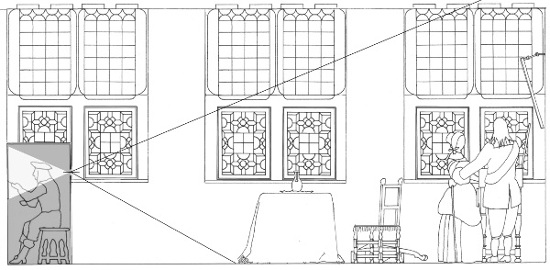
According to this scenario, Vermeer sat inside a large, booth- or tent-type camera fitted with a simple bi-convex lens, similar to a standard magnifying glass. This lens projects an upside-down, reversed image that can be traced on a piece of paper attached to the wall, and later correctly orientated and transferred to the canvas by one of various well-known techniques (counter-proofing, pouncing and gridding). However, depending on the level of illumination, the diameter of the camera's lens and the actual depth of the scene to be represented, the camera obscura may produce an image that is dim and unevenly focused.
Giuseppe Molesini's investigation into the quality of historic lenses yields the following information.Giuseppe Molesini, "The Optical Quality of Seventeenth-Century Lenses," in Lefèvre W., Inside the Camera Obscura—Optics and Art under the Spell of the Projected Image, Max-Planck-Institüt fur Wissenschaftgeschichte, Berlin, 117–128. "Although no seventeenth-century camera obscuras have survived, scientific testing shows that the surface regularity, shape and the glass homogeneity of lenses made for telescopes in that period were of the utmost quality. Thus, it must be assumed that the technology for producing a quality lens for the camera was available. Moreover, the imaging requirements for the camera were much lower than those used for telescopes, which, instead, were pushed to the limits. But even if such a lens were optically perfect in shape and glass quality, it could not overcome the basic imaging defects that become evident when it is used for the camera obscura." One of its most limiting factors, which is particularly crucial in tracing, is its narrow depth of field.
For example, had the lens of Vermeer's camera been focused on the background wall of scene represented in The Art of Painting, the foreground chair would have been far too blurry to make a suitable tracing. Moreover, in those works where the floor occupies a prominent part of the composition, it is difficult to discern, and hence trace with necessary precision, the floor tiles, whose contours are of fundamental importance in that they allow the artist to designate the exact location of distance points. If the tiles that abut the background wall are brought into tight focus, then those nearest the viewer—i.e., those along the lower edge of the picture—are so blurry and dim, that tracing them involves significant guesswork. To resolve this dilemma it would seem that one has only have to refocus the lens and continue tracing. However, refocusing is accomplished by moving the lens closer or farther from its initial position, and this movement alters the dimensions of the projected image so that the shapes of tiles of the two tracings no longer precisely connect: one set is slightly larger than the other. Moreover, by moving the position of the lens, the perspective is altered because the scene is viewed from a slightly different position. Refocusing and maintaining one central perspective are thus mutually exclusive. It has been sometimes suggested that the need to refocus the camera's lens can be avoided by simply stopping down (closing) the aperture of the lens,Narrowing the aperture of the lens, in photographic jargon, "stopping down" widens the focal length of the projected image and makes the image more precise. but in practice this causes the already dim projection to become dimmer still, making it virtually impossible to distinguish the outlines of objects that lie in shadow.
Even if Vermeer had discovered a way to bring the whole image into focus at one instant—there is no evidence that seventeenth-century lens makers had developed the technology for overcoming this decisive limit—precision tracing within the poorly lit parts of the scene remains problematic. A wider lens—Steadman advances that Vermeer could have had a lens 10 centimeter in diameter but others speculate much bigger lenses would have been availableSteadman speculates that such lenses were readily available in Holland in the seventeenth century. He writes that "some were made as conventional hand-held magnifying glasses. One such can be seen on the table in the Verkolje mezzotint portrait of Leeuwenhoek. It looks to be about 8 cm. in diameter. Magnifying glasses were commonly used in the Dutch cloth trade—in which Vermeer's father had worked—for inspecting the weave of delicate fabrics. Otherwise large lenses were being made, increasingly as the century progressed for use in telescopes. Even as early as the 1580s an English writer, William Bourne, had described the manufacture of 'perspective glasses' up to 12 inches (30 cm.) across. Constantijn Huygens, according to Monconys, possessed telescope lenses of 13.5 and 32.5 cm. diameter. The Royal Society has in its collection today three telescope lenses made by the younger Constantijn with diameters of 19.5, 21, and 23 cm., as big as dinner plates, all of which are dated 1686." From page 142 of: Philip Steadman, Vermeer's Camera: Uncovering the Truth behind the Masterpieces, 2001..—produces a more luminous image, but with a loss of image sharpness. In fact, there are many areas of Vermeer's scenes that are so scarcely illuminated, such as the foregrounds of Woman with a Pearl Necklace or Woman Holding a Balance, that the outlines of single objects would have sunk into an indistinct, milky darkness on the camera obscura's projection. In some cases, this handicap can be remedied by simple workarounds, which could have been discovered by any reasonably resourceful seventeenth-century painter. For example, one could temporarily open all (three) of the studio's windows and remove any curtains that had been used to "shape" the illumination, perhaps on a particularly sunny day, remembering that texture, and color and shape of shadows are irrelevant to perspective: all that is needed are edges. In certain circumstances it would also have been possible to reflect the incoming back into the shadowed side of a particular object by holding a large white board behind it. This is similar to how photographers use so-called "flats" or "bounce boards," especially with interior of buildings lacking sufficient available light.
A simple workaround also exists for locating the distance points with a camera obscura without having to trace both the foreground and background tiles. Ideated by the painter Carsten Wirth,Carsten Wirth, "The Camera Obscura as a Model of a New Concept of Mimesis in Seventeenth-Century Painting," in Lefèvre W., Inside the Camera Obscura—Optics and Art under the Spell of the Projected Image, Max-Planck-Institüt fur Wissenschaftgeschichte, Berlin, 149–194. this method consists in positioning a relatively large, uniformly colored "reference square" made of wood on the studio floor such that one of its sides abuts flat against the background wall, at a point where it receives bright light. This tile can be traced precisely and subsequently used to determine the distance points by extending the square's diagonals upwards to the left and to the right until they intersect the horizon line. Since the distance points in Vermeer's paintings fall outside the perimeters of camera's projection, the initial tracing could be laid over a larger piece of paper allowing the artist to develop the horizon line (determined by the heigth of the central vanishing point) and then distance points. Then, the painter had only to mark off the widths of the tiles at regular intervals along the background wall's base line and project lines from the distance points through them until they encounter the lower perimeters of the canvas. This simple method would have allowed the painter to create tiles of almost any dimension or pattern imaginable.
Curiously, one of the most persuasive arguments in favor of the camera obscura as a method for producing perspective concerns the actual dimensions of a group of Vermeer's paintings. It is important to know that when we reverse engineer a perspective from the painted surface of a picture, it is not possible to retrieve the absolute scale via geometrical relationships alone. Speaking strictly, we might equally well be seeing dolls in a dolls' houses as living people in normal-sized rooms.Philip Steadman, Vermeer's Camera. Uncovering the Truth Behind the Masterpieces (Oxford: Oxford University Press, 2001), 74. However, if we are able to determine the true dimensions of one or more objects represented in favorable conditions it is possible to deduce the absolute dimensions of other elements in the same picture, including those of the room's architectural features. Luckily, the dimensions of various key objects in Vermeer's paintings can be derived from corresponding artifacts preserved in museums which were manufactured to standard sizes, such as wall maps, globes, musical instruments, Delftware tiles and chairs (anatomical variations are too great to use the human models for the purpose of establishing absolute scale with the necessary precision). For example, "the reconstructed heights and widths of Vermeer's maps are, in all those cases where measurement is possible, within a few per cent of the surviving library copies, while the perspective reconstructions of the two types of chair give overall heights, and heights to the seats, that are within one or two centimeters of the museum originals."Philip Steadman, "Vermeer's Camera: afterthoughts, and a reply to critics," http://www.vermeerscamera.co.uk/reply3.htm. With these measurements Steadman found that the actual measurements of the objects in Vermeer's paintings are consistent not only within each separate painting but across a group of paintings that feature comparable architectural features and objects.
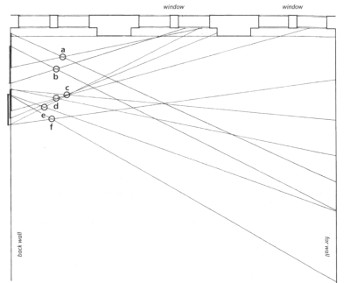
(image courtesy Philip Steadman)
Moreover, through reverse geometry, Steadman was "able to reconstruct the shape and dimensions of Vermeer's studio and all its furniture with considerable accuracy and plotted the theoretical viewpoints of half a dozen pictures within this space. Those parts of the room that are visible in each painting are contained within a 'visual pyramid' whose apex is at the viewpoint. If the sloping lines that form the edges of this pyramid are carried back through the viewpoint to meet the back wall of the room behind the painter, they define a rectangular area on that wall (fig. 34). In each of the six cases in question (and maybe more) this rectangle is the precise size of the respective painting."Philip Steadman, "Vermeer's Camera: afterthoughts, and a reply to critics," http://www.vermeerscamera.co.uk/reply3.htm. In Steadman's words, "this result can hardly be due to chance. It must be a product of Vermeer's working methods. Paul Taylor of the Warburg Institute made some calculations of the probability of the phenomenon occurring at random. He also consulted Tim Gowers, Rouse-Ball Professor of Mathematics at Cambridge. It is perhaps not very meaningful to cite a precise value for the probability, since any numerical result depends, among other considerations, on the assumptions made about accuracies of measurement. But on reasonable assumptions, Taylor and Gowers calculate that the odds are hundreds or even thousands-to-one against." This, Steadman believes, is because Vermeer traced them from the camera projection.
In itself, the fact that the viewpoints of six paintings falls at the same position in Vermeer's studio does not negate that Vermeer might have used a drawing frame or geometric construction, both of which allows the artist freedom in positioning the viewpoint. In fact, locating it at such a strategic point—it falls directly below a third window (hypothesized by Steadman)—would have had the advantage of allowing the painter to throw the maximum amount of light on his work area while comfortably observing the scene he was painting exactly as it had been represented in his perspective drawing. However, neither the drawing frame nor the geometric construction technique provides any sort of rationale behind the relationship between the location of the viewpoints and the dimensions of the six canvases, a highly unlikely statistical occurrence.Walter Liedtke questions the accuracy and consistency of Vermeer's perspectives, and argues that it is a basic mistake even to imagine that any Delft artist would have represented, in faithful detail, the exact appearances of some contemporary Dutch interior. Although rebutted by various art specialists—Walter Liedtke,Walter Liedtke questions the accuracy and consistency of Vermeer's perspectives, and argues that it is a basic mistake even to imagine that any Delft artist would have represented, in faithful detail, the exact appearances of some contemporary Dutch interior. Arthur K. Wheelock Jr., Jørgen WadumJørgen Wadum, review of Vermeer's Camera: Uncovering the Truth behind the Masterpieces, by Philip Steadman. ArtMatters—Netherlands Technical Studies in Art 1 (2002): 126–127. and Alan A. Mills.Allan A. Mills, "Response by Allan A. Mills," Leonardo 32, no. 2 (1999): 140–141.—Steadman remains firmly convinced that the camera explanation is simplest and most natural to the problem.
It should also be taken into account that neither geometric construction nor the drawing frame produce certain peculiar optical effects typical of Vermeer's mature paintings that a number of art historians and art writers have associated with camera obscura vision (e.g., pointillés, veracity of tone and selective focusing). In fact, it has been speculated that rather than rectifying the camera's optical idiosyncrasies and limitations, in certain cases Vermeer responded to them positively, incorporating them as stylistic components. For example, it has been claimed that the curious fuzziness of the foreground planes of The Art of Painting and The Lacemaker are a painterly transcriptions of camera's inability to bring into focus the entire pictured space without refcousing. Obviously, that Vermeer might have imitated some of the camera's quirks does not mean he employed the device for tracing. But the fact that the overwhelming number of critics (including those who do not agree Vermeer used the device to make tracings) concede that Vermeer's was at least familiar with camera obscura vision does offer some comfort to Steadman's hypothesis.
Addendum
When attempting to weigh the advantages and disadvantages of the camera obscura against those of the drawing frame we must not lose sight of the knowledge and skills required by the painter who might have built and used them.
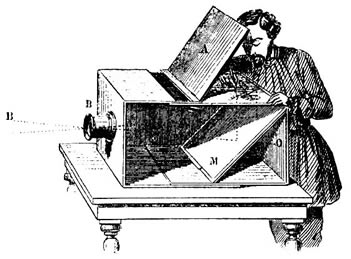
The construction of a camera obscura or a drawing frame is a very simple matter. Anyone with a discreet level of manual skill, a mat knife, masking tape, a five-and-dime-store magnifying lens, a sheet of tracing paper and a large piece of cardboard can construct a perfectly functional portable box-type (fig. 35) camera in the space of a morning. To construct a large booth-type camera, one needs greater amount of material to size up the box, and fit it with a door and a seat inside in order to remain comfortably seated while tracing the image projected on its back wall (it is best to paint the interiors of each device with opaque black paint to minimize unwanted reflections). Historians generally agree that Vermeer would have found no difficulty finding a lens of the quality and dimension needed to produce an acceptable image. A drawing frame is even simpler to make than the camera obscura.
Operating these devices requires no knowledge of optics or perspective. In the case of the camera, one must point it at the subject from an appropriate distance and slide the lens forward or backward to bring the image into focus on the screen—moving the lens can be done with a rudimentary sliding box-within-a-box diaphragm. As for the drawing frame, the user has to orient the frame toward the subject at a distance needed to encompass a specific area of interest when the eye is set at the tip of the positioning mechanism.
Like any auxiliary tool employed for the purpose of drawing or painting, both devices require a certain amount of practice to draw from, depending on the level of precision desired, even though a rudimentary drawing can be gotten from each device at the first go. Producing perspectives as accurate as those of Vermeer's most accomplished works, however, requires more than a few tries. Drawing with the camera obscura or drawing frame demands considerable patience and manual dexterity but certainly no more than that required by other highly evolved artisan-oriented processes where years of training are considered indispensable, such as etching, engraving, lacemaking, calligraphy or fine vase painting. In one sense, tracing from the camera is easier because the image remains absolutely still, while any movement of the artist's eye makes the scene shift with respect to the perimeters of the drawing frame. On the other hand, tracing from the camera is greatly affected by the dimness of the projection, while the scene observed through the frame remains absolutely consistent with normal viewing conditions. The camera demands a dose of intuition to distinguish outlines, and adaptive skills to overcome the problems associated with the unnatural orientation of the image and unevenness in focus. Moreover, the image of the camera must be eventually reversed left to right, a relatively time-consuming task. Some critics have pointed out that periphery of the camera's projection is distorted, but it would be no great task to extend the perspective lines originating from the focused area in the center of the projection outward once the tracing was brought outside the camera, remembering too that the areas around the edges of Vermeer's compositions tend to be relatively uncomplicated. It may be possible to use a ruler to obtain straight lines or a maulstick to steady the drawing hand with both devices, although this idea has not been tested.
It should be remembered nothing obliges the artist using the drawing frame or the camera obscura to produce a finished and completely accurate drawing from the beginning, and with either device it may be too much to expect to produce them without subsequent revision. A reasonably resolved drawing may be reworked to a higher level of precision once the artist has removed it from the apparatus and has set it in a more comfortable position on a large, flat surface. By approximating the main perspective elements (i.e., orthogonals and distance lines) with light but ruled lines he may then fix the central vanishing point at its most probably location in the case that the orthogonals do not intersect precisely at a single point. The orthogonals can then be redrawn with a ruler to the definitive vanishing point. If the distance points are expected to fall outside the initial drawing, all the artist has to do is attach other pieces of paper to its sides, respecting the fact that both points must be equidistant from the central vanishing point. The horizontal line must be extended laterally (through the central vanishing point) to accommodate the distance points. Then, the distance points can be redone and in the same way as the central vanishing point, the distance lines redrawn, and all the transversals straightened out. If one possesses a good knowledge of linear perspective, the better. The parts of the drawing where perspective is not crucial can be refined to the desired level. Depending on its original size, the drawing can be resized, if necessary, and transferred by one or another well-known techniques to the canvas.
It is easy to see that each device has its pros and cons. But to what degree do the advantages and constraints of one outweigh the advantages and constraints of the other? The answer may lie not exclusively in the functionality of the devices, but, as suggested above, the artistic priorities and the specific skill set of the individual artist who employs them (a painter who is interested in the unique optical qualities produced of the image produced by the camera may be more inclined to use the device for drawing as well, but strictly speaking, there is no reason he may not use them in tandem).
If the above assumptions are correct, both devices would be much more practical than geometric construction for producing perspectives as accurate as Vermeer's. The pin-and-string technique seems most practical as a method for verifying or tidying up rather than constructing perspectives.
Knowledge: What did Vermeer Know?
Although Vermeer was probably not learned as the great French classicist painter Nicolas Poussin (1594–1665), who was a man of extraordinary culture and intellectual sophistication in his own right, evidence points to the fact that he was at least a knowledgeable painter. And ambitious. Differently than most Dutch painters, Vermeer opted for the high-brow category of painting, historia, as the starting point for his career. His most ambitious compositions suggest he was aware of latest developments in Dutch painting, including the use of symbols as a means to infuse moral meaning to painting as well as the longstanding debates concerning the art of painting still rife throughout Europe, such as il paragone. And he was almost certainly aware that linear perspective, which, being founded on mathematics, was routinely evoked to vindicate the status of painting as a liberal, rather than a manual, art. Furthermore, as already written, Vermeer was lauded by a contemporary art lover for his mastery of perspective. There is, however, no documentary evidence that informs us exactly how he came to know about linear perspective or precisely what he knew, but it would have been almost impossible for him to have ignored the pervasive culture of perspective that had developed around two generations of pioneering architectural painters working in Delft and nearby The Hague.
From what we can deduce from his paintings Vermeer was knowledgeable about the basic concepts associated with one- and two-point perspective, such as the central vanishing point, the horizon line, orthogonals, lateral distance points and distance lines (for further analysis of this topic, click here). He knew, or had intuited, that distance points must be equally spaced from the vanishing point and that the space between the distance points is directly related to the real-life distance between the painter and his subject. He knew, or had intuited, that objects turned at oblique but not 45 degree angle to the viewer require a separate set of distance points, then termed "accidental points," although he did not apply this knowledge with consistent expertise. It is, however, impossible to determine if he possessed sufficient knowledge to project a perspective from a plan and elevation. Despite the capillary diffusion of linear perspective, the only painter who is known to have ever used this method before Vermeer painted was Saenredam.
We may say that Vermeer's knowledge of linear perspective elevates him above most domestic interior painters of the time but not the most accomplished Dutch architectural painters. Although Vermeer's perspectives are indeed more accurate than those of the overwhelming number of interior painters of the time, there is no evidence that he made any innovations in the theory of linear perspective. It would appear was simply more careful and more judicious in its application.
Skill
As the art writer James Elkin pointed out, although art historians are generally seen as wanting artists to possess "supreme, untouchable skill, adequate to every object, they, in fact, often underestimate the technical abilities of artists because they themselves don't draw. They just don't think about skill because they are too concerned with the historical meanings and functions of the art. Since so few art historians engage in discussions about it, skill it is, for all practical reasons, a dead issue." Nonetheless, it may still be useful to address the question of artistic skill in at least its most general form.In past decades various experiments have been performed with the camera obscura, generally by unskilled laymen or painters whose manipulative skills and knowledge of painting materials are hardly comparable to those the finest Dutch painters. None of the experiments were specifically formulated to test the device's viability as a tool for creating perspective in real studio circumstances by a skilled painter. The drawing frame has never once been tested in reference to the work of Vermeer.
When evaluating the practicality of the camera obscura or the drawing frame we must remember to take into account not only the inherent qualities of these devices but questions regarding the skill set possessed by many seventeenth-century painters, particularly the Dutch, which was much higher than that of the overwhelming part of their modern figurative counterparts. There is, in fact, no painter alive today who would dare claim to possess either the level of skill of the intimate knowledge of craft possessed by so many sixteenth- and seventeenth-century painters. Not a single modern artist can rival the ineffable delicacy of Gerrit ter Borch's brushwork or the breathtaking manual control displayed in the engravings of Hendrick Goltzius (1558–1617) (fig. 36).This divide was hardly confined to the fine art of painting, where unwittingly skill is oftentimes conflated with artistic excellence. Generally speaking, in Western forms of the applied arts, such as lacemaking, calligraphy, mapmaking, gold and silversmithing, glassmaking, clockmaking, and engraving skill levels, which were widely diffused, are barely approachable today. The sheer skill and the ability necessary to manage pictures of enormous visual and technical complexity possessed by the most accomplished painting technicians, such as Jan van Eyck (c. 1390–1441), Dürer, Rembrandt or Vermeer, was even greater, in some case almost unimaginably so.
To comprehend this divergence we must take into account past and present teaching methods. Rather than looking at the largely unsystematic education of today's painters, where discipline is treated with barely feigned disdain in cutting-edge institutions, it is best to turn to the training regimes and discipline imposed upon today's classical musician or ballet dancer, whose skills, like those of the most ambitious painters of the distant past, were built up through endless practice from an early age on.Ernst van de Wetering, Rembrandt: The Painter at Work (Berkeley: University of California Press, 2004). It should be taken into account that within the incredibly competitive Dutch art market painting was anything but a leisurely activity in which the gentleman-artist was free to pursue "self expression." In order to distinguish their goods from those of the myriads of other artists, the most competitive painters were constrained to seek some sort of incremental advantage, a process which spurred an almost fanatical pursuit of technical perfection. The incentive to create evermore innovative and accurate perspective paintings was particularly great, as such works were among the most highly paid.
It would be, then, somewhat simplistic to suppose that what may strike the modern art historian or painter as an insurmountable technical barrier of this or that method would have been necessarily so for Vermeer, or other highly skilled painters of his time. Moreover, it is well known that painters worked hand in hand with artisans who could have helped them resolve technical problems not usually associated with fine art painting. It is the opinion of the present writer than the works of these artists demonstrate time and time again that they possessed the manual dexterity, skills and ingenuity which would allowed them to improvise workarounds and compensate for the deficiencies presented by any of the methods discussed herein, except for the pin-and-string method.
In any case, besides creating correct perspective, both the camera obscura and the drawing frame would have permitted Vermeer to objectively explore the effects of the transformation in shape of objects projected from particular points of view. In particular the camera obscura allows one to immediately observe how form can become extremely deformed when projected on a flat surface yet remain recognizably the same object. Martin Kemp pointed out that if "it may be no coincidence that the artists with the greatest intellectual control over perspective geometry…have also exhibited a heightened awareness of the flat shapes of objects on the picture plane." Whether Vermeer mastered perspective by geometrical, mechanical or optical means, his urge to probe the limits of this fundamental dichotomy of pictorial representation while remaining one of the most naturalist of painters is one of the hallmarks of his art.
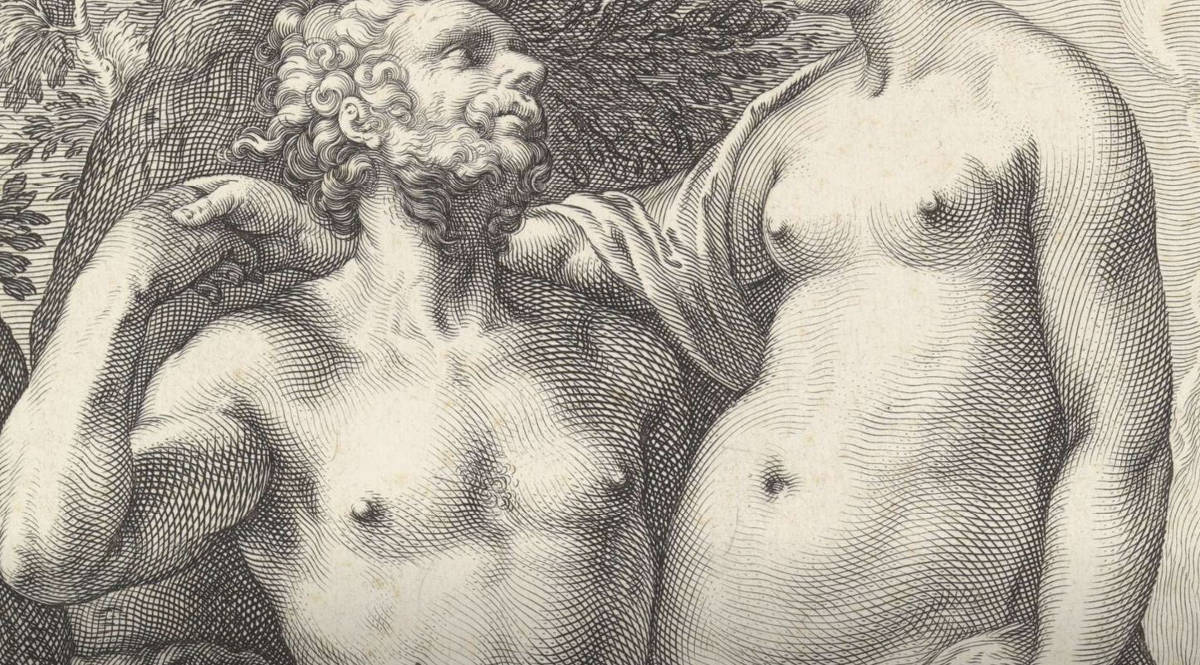
Hendrick Goltzius
1575–1607
Engraving on paper, 32.6 x 21.6 cm.
Rijksmuseum, Amsterdam

